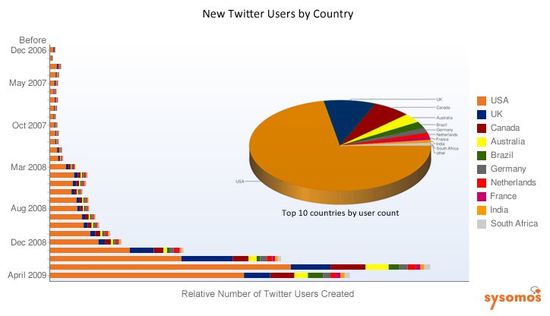
Last month a social media analytics provider named Sysomos released a comprehensive report on Twitter usage. The problem with most analysis on Twitter, though, is that it is limited by the minimal amount of data that Twitter collects. So, to fill the gaps, most reports do things like guessing gender based on real names or pulling data from keywords in people’s biographic information. This often yields some questionable results – and the Sysomos report is not immune to this (for example, they find that 65% of Twitter users are under the age of 25, but base this on only the 0.7% of users who actually disclose their age).
Looking past these small points, the report does share some fairly interesting observations and stats as well if you dig a bit deeper. Here’s my read on the 10 standout conclusions that the report offers to help you (and your brand) better understand the potential uses of Twitter:
- 21% (One Fifth) of Twitter accounts are empty placeholders. These are the percentage of Twitter accounts that have never posted a single tweet. They may either be registered simply to hold a username for later use, or be experimental accounts started up but never used.
- Nearly 94% of all Twitter accounts have less than 100 followers. In a finding perhaps consistent with the newness of the tool as well as the fact that many people may currently have an account simply to start experimenting with the tool, Sysomos found the vast majority of Twitter users have an extremely low followership.
- March and April of 2009 were the tipping point for Twitter. During these months, Ashton Kutcher launched his quest to get to 1 million followers faster than CNN, Oprah started using Twitter, and the steady flow of new users to the site continued. For many, it offered a safer and easier way to get their feet wet with social media, 140 characters at a time.
- 150 followers is the magic number. In a particularly interesting data point from the survey, Sysomos found that Twitter users tended to “follow back” all their followers up until about 150 connections. Then the reciprocation rate fell off dramatically, which seems to indicate that this number may be the crossover point where people shift from using Twitter for more personal use to using it more for “lifecasting” their thoughts and actions to a community of people who they feel varying levels of connection to.
- A small minority creates most of the activity. A steep curve of a small minority of actively engaged content creators generating most of the activity on a site is common among social networks, but it is steeper and more pronounced on Twitter. 5% of users account for 75% of all activity, and 10% of users account for 86%. This seems to suggest that the site has managed to engage a mass audience beyond those who typically engage with social media.
- Half of all Twitter users are not “active.” If you take a general description of being “active” on Twitter to mean that you have posted a tweet at some point in the last 7 days (1 week), then the survey learned that 50.4% of all Twitter users fit this category. If you remove the 21% from point #1, this leaves about 30% of users who have an account and have tweeted before, but happen to be inactive now.
- Tuesday is the most active Twitter day. One of the most useful data points from the report is that it clears up the common question of which day of the week is the best day to tweet something. Sysomos found that Tuesday stood out as the most popular day for tweets and retweets, followed by Wednesday and then Friday.
- APIs have been the key to Twitter’s growth & utility. In terms of tools that people are using for Twitter, Sysomos found that more than half (55%) of all Twitter users use something other than Twitter.com to tweet, search and connect with others. This may, in part, be due to Twitter’s notorious reputation of failing/crashing, but also is a credit to all the third party applications that have been built on top of Twitter and do their fair share to bring new users to the service.
- English still dominates Twitter. When exploring Russia as part of a class that I am teaching this summer at Georgetown, one of the barriers we learned about was the difficulty of fitting some Russian language words into just 140 characters. Twitter is, however, extremely English-friendly. As the Sysomos report found, the top four countries on Twitter are all English speaking (US, UK, Canada, Australia). Of these, US makes up 62% of all Twitter users, followed by UK with nearly 8% and Canada and Australia with 5.7% and 2.8% respectively. The largest non-English speaking country on Twitter? Brazil with 2%.
- Twitter is being led by the social media geeks. This particular finding should likely come as no surprise, but 15% of Twitter users who follow more than 2000 people identify themselves as social media marketers. These individuals are more likely to post updates every day (sometimes more than once per day) and also use Twitter more actively for direct communication.
Bonus Geographical Stat/Quote: “The cities with the biggest Twitter populations are New York, Los Angeles, Toronto, San Francisco, and Boston. Los Angeles is the fastest growing city on the list.”
Download the full report from Sysomos at http://www.sysomos.com/insidetwitter/








WE RECENTLY REMOVED COMMENTING - LEARN WHY HERE >